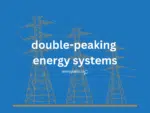
While most consumers and businesses understand at a base level what energy peaks are and that we should be avoiding them to get the best prices on our energy bills – energy use and electricity peaks are more complicated than many think. Dodging these peaks is a big obstacle towards the goal of securing the best electricity rates and involves a lot of legwork to understand how it works and to keep up with the ever-changing numbers and systems in place.
This article explains what double peaking is, why Alberta is becoming a double-peaking system, and what this means for Albertans, what the province is currently doing to expand grid capacity, along with general information about varying types of electricity peaks and what these can mean for you as a consumer.
What is a double-peaking system?
Double-peaking is, as the name implies, where instead of one peak, there are multiple. The time of the day when electricity use tends to ‘peak’, such as in the evening when most are home from work or similar as examples is a regular occurrence that businesses especially try to beat to save costs on power bills. Many don’t know that there are multiple types of peaks and what causes them, with double-peaking being one – it is essentially when everyone avoids a certain time window because of predicted peak times, only for those hours directly before and after becoming the ‘real’ peaks and thus defeating the whole purpose of trying to avoid the peak hours of use.
Double-peaks can cause issues for any business’s energy strategies, as the benefit from ‘beating the peak’ falls short, and it ends up being more expensive because of the accidental actual peak usage. Trying to benefit from demand and curtailment programs can be ineffective due to these issues, and double peaks are a symptom of the fact that other consumers are also trying to beat the market as well, as everyone is trying to avoid the high-priced hours.
Why is Alberta becoming one?
Commonly speaking, a large percentage of the population will base energy usage decisions on the same publicly available information on peak hours and times, which will of course influence a large portion of the market to load shift over the same hours and since everyone else is doing the same – it of course leads to the real peaks happening in the hours before and after the predicted peak was originally, causing these doubles. If, for example, the public data from local system operators predicts a peak at 5-6 pm, any businesses looking to reduce the peak hour usage payments are going to be motivated to reduce or change their energy use to hours outside of that.
Alberta is known for its rather high electricity prices in comparison to other provinces, and over the last few years, the supply and demand of the electrical grid have been noticeable. Record low temperatures mixed with higher heat usage and no wind power plans generating extra power, the peak usage was putting a huge strain on the grid.
That said, normally the peaks are in winter more so than in summer. In Alberta, the record-high electricity demand peaks used to be registered in the coldest months. Now, summers are becoming peak usage times as well, making it so that the grid is being strained during both the winter and summer months.
Demands are rising fastest in areas that don’t typically have air conditioning built in, such as in most areas of Canada. Cooling alone represents 10% of global electricity demand. In hotter countries, it can drive a rise in electricity demand by more than 50% in the summer. In the hottest regions, the grid capacity needs to cover a doubling of electricity demand compared to milder months, and that can equal out to a whopping 70% electricity peak demand on account of cooling. When it comes to winter-time heating, more and more regions are experiencing the dual peaking issues with distinct summer and winter peaks, including Alberta.
An MSA report has stated specifically about Alberta that: “Alberta becomes double peaking system: demand in July was elevated, driven by high ambient temperatures and increased air conditioning load. Hourly demand in July was above the previous summer demand peak on 73 different occasions. The new summer peak of 12,221 MW is just 163 MW short of the winter demand peak set in January.
Demand in July was 5% higher year-over-year, driven by high temperatures and increased air conditioning load. The previous summer peak set in June 2021 was exceeded 73 times in July due to record cooling loads. The new summer peak of 12,221 MW was set on July 22 in hour ending 17 (HE 17). This new record is 500 MW higher than the old summer peak and 163 MW short of the winter demand peak.”
What this means is that in the future, we will be peaking more often than not during our most used times of the year, and that isn’t going to be slowing down; if anything, it will continue to rise.
What does this mean for Albertans, and how can it affect energy prices?
Keeping cool (and warm) in a changing climate makes efficiency more important than ever, especially with a growing population using more and more cooling and heating throughout the year, and years to come, it will only become more important.
Heat alerts, especially, have been on the rise globally and with the world hitting the hottest days we have on record, the sales of air conditioners have gone up, boosting weekly sales by 16%, and Google searches are also up by 25% for air conditioners. In Alberta, the use of air conditioners in the hot summer months has skyrocketed, and the strain on the electrical grid has been noticeable, with AESO asking people to reduce their usage if possible. The problem with this is that the weather temperatures are hitting higher every year, resulting in the grid needing to be more efficient and ready to handle these dual peaks during the year, not including any random moments that may need to be addressed outside of the main summer and winter months.
With these elevated pressures, people may have felt these problems in their wallets, with electricity and natural gas bills rising. What this means for Albertans is that a double-peaking system could mean either even higher rates and bills, or, if it’s leveraged correctly, could have a minor effect in the province compared to other regions.
Increasing grid capacity
According to the 2024 Annual Market Statistics report by the Alberta Electric System Operator (AESO), rapid generation capacity growth strengthened the grid and reduced the likelihood of future grid alerts while allowing the province to meet record-setting demand. Alberta’s total installed generation capacity increased by more than 11% in 2024; more than 3,000 megawatts (MW) were added to the grid. For the first time since 2016, Alberta became a net exporter of electricity, and electricity prices dropped by 53%.
It’s important to note that Alberta’s electricity demand reached record levels in 2024, and new records were established for both winter and summer.
This means that, although becoming a double-peaking system may have impacted electricity rates in the recent past in Alberta, there are plenty of new power plants going live in the province, which expands grid capacity and reduces the risks of grid alerts.
Why does double peaking matter?
Double-peaking systems matter because the electricity grids weren’t made for the number of peaks that we keep hitting throughout the year. They are made for peaks and valleys, of course, but they’ve been rising, and that’s hard to keep up. Overestimation of future peak demand results in utilities building too much generation and transmission infrastructure, and overcharges can affect customers.
Utilities with the same level of peak demand in different seasons could, and should, have different resource plans and it’s important that utility resources planning accurately reflects when and where peaks are most likely to occur and have contingencies in place to ensure that it doesn’t put a large issue on the grid across the province. Another mention is that when utilities don’t peak at the same times, there is an opportunity for one utility system to share resources with the next one to meet peak demands. Sharing resources like this can reduce the overall need for resources across the province and country, which would reduce costs for consumers and businesses.
Next steps and takeaways from this information are that utility forecasting and resource planning are great first steps in the process that can help shape the electricity grid for the better. Utilities continuing to overestimate future peak demand and forecasting a shift from one seasonal peak to another, despite historical trends, can make a big difference in how it will affect Albertans down the road.
For more information about shifting energy rates, electricity grids and how they work across Canada, and in Alberta, and for other unbiased information in regards to energy efficiency, electricity and natural gas rates, and more, EnergyRates.ca has easy-to-find and read information all about energy across Canada.











